Overview of IT Governance Maturity Models
IT governance maturity models provide organizations with a structured approach to assessing and improving their IT governance processes, policies, and practices. These models help organizations understand their current level of IT governance maturity and identify areas for improvement. In this section, we will discuss the concept of IT governance maturity models, their key components, and some examples of widely used models.
IT governance maturity models are typically based on the premise that IT governance effectiveness can be measured along a continuum, with different stages representing increasing levels of maturity. These stages are defined by specific characteristics, practices, and outcomes that can be observed and assessed within an organization. The goal of using a maturity model is to help organizations progress from lower to higher levels of maturity, ultimately achieving a more effective and efficient IT governance system.
Some key components of IT governance maturity models include:
- Maturity Levels: These are the distinct stages of IT governance maturity, usually represented by a numeric scale (e.g., 1 to 5) or descriptive labels (e.g., “ad hoc,” “defined,” “managed,” etc.). Each level represents a specific set of characteristics and practices, with higher levels indicating more mature and effective IT governance processes.
- Assessment Criteria: Maturity models typically include a set of criteria or indicators that organizations can use to assess their current level of IT governance maturity. These criteria may be grouped into categories or domains, such as strategy, risk management, performance measurement, and resource management.
- Improvement Pathways: Maturity models often guide how organizations can progress from one maturity level to the next, including specific actions, practices, or initiatives that can help drive improvement.
Examples of widely used IT governance maturity models include:
- COBIT Maturity Model: This model is based on the COBIT framework and assesses IT governance maturity across five levels, ranging from “non-existent” (Level 0) to “optimized” (Level 5). The model evaluates maturity in various domains, such as strategy, risk management, and performance measurement, based on a set of predefined assessment criteria. The capability level represents the effectiveness and performance of a process’s implementation (see Figure 1). In contrast, the maturity level, linked to specific focus areas, indicates the extent to which the processes within these focus areas reach the defined capability level. This is achieved by gathering substantial evidence that underpins the achievement of enterprise objectives (refer to Figure 2).
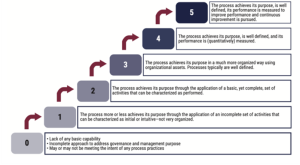
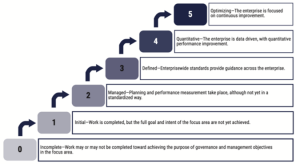
- ITIL Maturity Model: This model is aligned with the ITIL framework and focuses on assessing the maturity of IT service management processes. It also uses a five-level scale, ranging from “initial” (Level 1) to “optimizing” (Level 5), with each level representing an increasing degree of process maturity, control, and effectiveness.
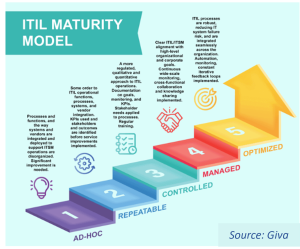
- CMMI (Capability Maturity Model Integration): Though not specifically designed for IT governance, CMMI is a widely used maturity model that can be applied to various disciplines, including IT. It assesses organizational maturity across five levels, from “initial” (Level 1) to “optimizing” (Level 5), focusing on process improvement and performance optimization.
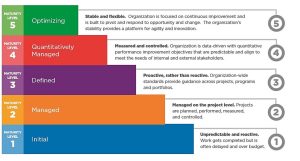
IT governance maturity models provide organizations with a structured approach to evaluating and improving their IT governance practices. By understanding their current level of maturity and following improvement pathways, organizations can work toward more effective IT governance processes that support business objectives and deliver value.
Assessing an Organization’s IT Governance Maturity Level
Assessing an organization’s IT governance maturity level is crucial for identifying areas of improvement and developing strategies to enhance IT governance effectiveness. In this section, we will discuss the steps involved in assessing an organization’s IT governance maturity level and provide examples to illustrate the process.
Step 1: Select an appropriate maturity model
The first step in assessing an organization’s IT governance maturity level is to choose a suitable maturity model. As mentioned earlier, some popular IT governance maturity models include COBIT, ITIL, and CMMI. The choice of model should align with the organization’s specific IT governance framework, industry, and strategic objectives.
Step 2: Define the assessment scope
Determine the scope of the assessment by identifying the specific IT governance domains, processes, or areas that will be evaluated. This may include areas such as strategic alignment, risk management, performance measurement, and resource management. Clearly defining the scope will help focus the assessment on the most critical aspects of the organization’s IT governance system.
Step 3: Assemble a cross-functional assessment team
Form a diverse team of stakeholders, including IT leaders, business executives, and subject matter experts, to participate in the assessment process. A cross-functional team can provide a comprehensive understanding of the organization’s IT governance practices and ensure that different perspectives are considered during the assessment.
Step 4: Collect and analyze data
Gather data on the organization’s IT governance practices and performance by conducting interviews, surveys, and document reviews. The assessment team should analyze this data to identify trends, patterns, and areas of concern. This analysis will help the team understand the organization’s current IT governance maturity level and pinpoint specific areas for improvement.
For example, suppose the assessment team discovers that the organization lacks a formal process for prioritizing IT investments based on their strategic alignment and expected value. This finding may indicate a low maturity level in the strategic alignment domain, suggesting that the organization needs to enhance its decision-making processes in this area.
Step 5: Benchmark against the chosen maturity model
Compare the organization’s IT governance practices and performance against the criteria and indicators defined by the chosen maturity model. This comparison will help the assessment team determine the organization’s maturity level for each domain, process, or area within the assessment scope.
For instance, using the COBIT maturity model, the assessment team might determine that the organization’s risk management practices align with a Level 3 maturity (defined), indicating that risks are formally managed but could be improved by adopting more proactive and advanced practices.
Step 6: Develop improvement recommendations
Based on the assessment findings and maturity level analysis, the assessment team should develop recommendations for improving the organization’s IT governance practices. These recommendations should be prioritized based on their potential impact, feasibility, and alignment with the organization’s strategic objectives.
Step 7: Communicate the assessment results
Share the assessment results, including the organization’s maturity level, areas of concern, and improvement recommendations, with relevant stakeholders. This communication should promote transparency, foster buy-in for improvement initiatives, and ensure that stakeholders understand the value of enhancing the organization’s IT governance practices.
Assessing an organization’s IT governance maturity level involves selecting an appropriate maturity model, defining the assessment scope, assembling a cross-functional team, collecting and analyzing data, benchmarking against the chosen model, developing improvement recommendations, and communicating the results. This process helps organizations identify areas for improvement and develop targeted strategies to enhance IT governance effectiveness and support business objectives.
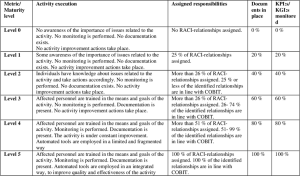
Developing a Roadmap for IT Governance Maturity Improvement
Once an organization has assessed its IT governance maturity level and identified areas for improvement, the next step is to develop a comprehensive roadmap for enhancing IT governance practices. A well-designed roadmap can guide the organization through the process of implementing the necessary changes and tracking progress toward the desired maturity level. In this section, we will discuss the key steps involved in developing an IT governance maturity improvement roadmap and provide examples to illustrate the process.
Step 1: Establish a clear vision and objectives
Begin by articulating a clear vision and objectives for the IT governance maturity improvement initiative. This vision should outline the desired future state of the organization’s IT governance practices and explain how these improvements will support the overall business strategy. Ensure that the objectives are specific, measurable, achievable, relevant, and time-bound (SMART) to enable effective tracking of progress.
For example, an organization’s vision might be to achieve a Level 4 maturity in IT risk management within two years, allowing for proactive risk identification and mitigation that supports business growth.
Step 2: Prioritize improvement areas
Based on the assessment findings, prioritize the improvement areas identified by considering their potential impact on the organization’s strategic objectives, the feasibility of implementing changes, and the available resources. This prioritization will help focus the roadmap on the most critical aspects of IT governance maturity enhancement.
Step 3: Define the improvement initiatives
For each prioritized improvement area, develop specific initiatives or projects to address the identified gaps and weaknesses. These initiatives should include a clear description of the required actions, the expected outcomes, the responsible parties, and the necessary resources.
For instance, to improve the organization’s IT risk management maturity, an initiative could be to implement a comprehensive risk assessment methodology that considers both qualitative and quantitative factors and assigns clear roles and responsibilities to stakeholders.
Step 4: Develop a timeline and milestones
Create a realistic timeline for implementing the improvement initiatives, taking into consideration the complexity of the projects, the organization’s capacity for change, and the availability of resources. Establish milestones for each initiative to track progress and ensure timely completion. This timeline should be flexible enough to accommodate changes in the organization’s priorities or resource constraints.
Step 5: Allocate resources and assign responsibilities
Identify the resources, including budget, personnel, and technology, required to implement the improvement initiatives. Assign responsibilities to specific individuals or teams for executing each initiative and ensure they have the necessary skills, authority, and support to be successful.
Step 6: Establish monitoring and reporting mechanisms
Develop a process for monitoring the progress of the improvement initiatives and reporting on their outcomes to relevant stakeholders. This process should include regular reviews of the milestones, performance metrics, and risk factors associated with each initiative, as well as adjustments to the roadmap as needed to address emerging issues or changing priorities.
Step 7: Communicate the roadmap and engage stakeholders
Effectively communicate the IT governance maturity improvement roadmap to all relevant stakeholders, including executive management, IT teams, and business units. Engage stakeholders in the improvement process by soliciting their input, addressing their concerns, and providing regular updates on progress. This engagement will help foster buy-in, facilitate collaboration, and ensure that the improvement initiatives align with stakeholder expectations and needs.
Developing a roadmap for IT governance maturity improvement involves establishing a clear vision and objectives, prioritizing improvement areas, defining improvement initiatives, developing a timeline with milestones, allocating resources and assigning responsibilities, establishing monitoring and reporting mechanisms, and effectively communicating the roadmap and engaging stakeholders. By following this process, organizations can systematically enhance their IT governance practices, achieve the desired maturity level, and better support their strategic objectives.